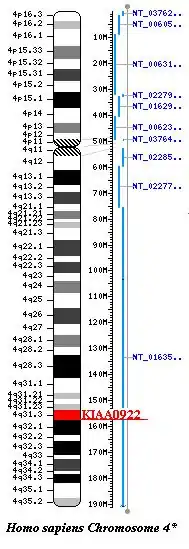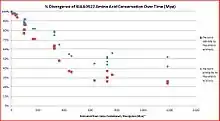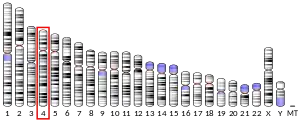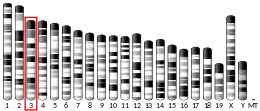KIAA0922
Transmembrane protein 131-like (TMEM131L protein), alternatively named uncharacterized protein KIAA0922 (KIAA0922 protein), is an integral transmembrane protein[5] encoded by the human gene KIAA0922 that is significantly conserved in eukaryotes, at least through protists.[6][7][8] Although the function of this gene is not yet fully elucidated, initial microarray evidence suggests that it may be involved in immune responses. Furthermore, its paralog, prolyl endopeptidase (PREP) whose function is known, provides clues as to the function of TMEM131L.
| TMEM131L | |||||||||||||||||||||||||||||||||||||||||||||||||||
|---|---|---|---|---|---|---|---|---|---|---|---|---|---|---|---|---|---|---|---|---|---|---|---|---|---|---|---|---|---|---|---|---|---|---|---|---|---|---|---|---|---|---|---|---|---|---|---|---|---|---|---|
| Identifiers | |||||||||||||||||||||||||||||||||||||||||||||||||||
| Aliases | TMEM131L, D930015E06Rik, Kiaa0922, mKIAA0922, KIAA0922, transmembrane 131 like | ||||||||||||||||||||||||||||||||||||||||||||||||||
| External IDs | OMIM: 616243 MGI: 2443399 HomoloGene: 9057 GeneCards: TMEM131L | ||||||||||||||||||||||||||||||||||||||||||||||||||
| |||||||||||||||||||||||||||||||||||||||||||||||||||
| |||||||||||||||||||||||||||||||||||||||||||||||||||
| |||||||||||||||||||||||||||||||||||||||||||||||||||
| |||||||||||||||||||||||||||||||||||||||||||||||||||
| Wikidata | |||||||||||||||||||||||||||||||||||||||||||||||||||
| |||||||||||||||||||||||||||||||||||||||||||||||||||
Gene

The KIAA0922 gene is found in the human genome at chromosomal location 4q31.3 on the plus strand and is 170,364 base pairs (bp) in length, spanning from 154,387,498 to 154,557,863[9] along chromosome 4 (NC_000004.11).[10] The gene has the aliases TMEM131L, FLJ10592, DKFZp586H1322, and LOC23240 [11] The gene includes 44 distinct introns (with an additional 6 probable non-overlapping alternative last exons).[11] The function of this gene is not yet fully understood.
The gene includes the Domain of unknown function 3651 (DUF3651) which is part of the transmembrane associated family pfam12371 and of the superfamily cl13764.[12] The mature mRNA of certain transcript variants have a confirmed signal peptide region.[13] although protein localization remains unknown.
mRNA
KIAA0922 mRNA is around 5 kilo-base pairs(kbp) in length.[9] Thirteen splice variants are supported by ACEVIEW analysis but only two have been experimentally identified.[11] Mostly, different variants seem to vary based on differing truncation of the 3' and 5' ends (especially due to the presence of an upstream stop codon in the exonic region).[11]
Protein
Protein TMEM131L is an integral membrane protein[5] and is also known as OTTHUMP00000205136.[11] The protein TMEM131L Isoform I is 1,610 amino acids in length[14] and its primary structure weighs 179.209 kilo-Dalton (unit) (kDa).[10] Twelve different isoforms of this protein have been predicted (one partial, six COOH complete, and five complete) however there have been only 5 experimentally observed.[11]
Expression
The protein TMEM131L shows highest levels of expression in immune related cells and tissues such as lymphocytes and bone marrow.[7] Levels of TMEM131L protein have been shown to significantly increase under certain immune responses, such as increasing over time after introduction of measles virus to the immune cells dendritic cells[15] and in peripheral blood lymphocytes from kidney transplants displaying acute rejection.[16]
Transmembrane region
There is only one confirmed transmembrane domain region in protein TMEM131L.[13] This domain exists near the center of the protein, at 871-891 amino acid of the 1610 amino acid long protein sequence (for isoform I).[13]
There is a dramatic switch from hydrophobic to hydrophilic amino acid density at this confirmed transmembrane region.[17] There is also a switch to a higher density of predicted N-linked glycosylation sites across this confirmed transmembrane region (0.0136 to 0.0069 predicted N-glycosylation sites/amino acid) at this region.[18] Furthermore, the only confirmed phosphorylation site is on the latter half of the protein (1,123 aa in isoform I)[13] and predicted phosphorylation sites increase in density across the confirmed transmembrane region (from 0.0386 to 0.0905 predicted phosphorylation sites/amino acid).[19] These results together indicate that the first half of the protein (1-871 aa of isoform I) is outside of the membrane while the second half (891-1610 aa of isoform I) is inside of the membrane, although experimentation is necessary to confirm this deduction.
Paralogs
Prolyl endopeptidase
The enzyme prolyl endopeptidase (PREP) is 13.4% identical to transmembrane protein 131L.[20][21][22][23] PREP acts in the cytosol by cleaving peptide bonds on the C-terminus of short prolyl residues (approx. 30 amino acids long).[24][25] PREP has been found to be involved with the maturation and degradation of neuropeptides and peptide hormones.[26] PREP and its general functions are conserved through flavobateria.[27]
Of particular interest, the highest areas of amino acid conservation between PREP and KIAA0922 are the areas most conserved in KIAA0922 (KIAA0922#Conservation) are the esterase lipase region (483...706)[28] and peptidase S9 N region (7...423)[28]
This connection may help direct the efforts to elucidate the function of transmembrane protein 131L.
Transmembrane protein 131
Transmembrane protein 131L is 36% identical and 54% similar to transmembrane protein 131. The gene for transmembrane protein 131 is found on chromosomal location 2q11.2 and the protein is 1883 amino acids long and is also an integral membrane protein.[29][30] However, research indicates that the TMEM131L protein is more highly methylated than the TMEM protein.[13]
Conservation

Following Biology Workbench[20] multialign CLUSTAL W[8] analyses, certain regions of TMEM131L protein are highly conserved through Eukaryotes as distantly as single-celled protists (24% identity with Dictyostelium fasciculatum).[31] These exact same regions also appear to be conserved in the KIAA0922 paralog Prolyl endopeptidase (PREP), a gene for a cytostolic enzyme that cleaves the C-terminus of short polyl proteins.[13]
| Genus and Species Name | common Name | mRNA Accession Number[32] | Sequence Length (amino acids)[32] | Sequence Identity to human mRNA[31] | Sequence Similarity to human mRNA[31] |
|---|---|---|---|---|---|
| Homo sapiens | Humans | NM_001131007.1 | 1624 | ||
| Pongo abelii | Sumatran orangutan | XP_002815269.1 | 1608 | 98% | 99% |
| Loxodonta africana | Elephant | XP_003417575.1 | 1610 | 86% | 92% |
| Mus musculus | Mouse | NP_766269.3 | 1597 | 77% | 86% |
| Ornithorhynchus anatinus | Platypus | XP_001514395.2 | 1609 | 71% | 82% |
| Gallus gallus | Chicken | XP_420366.3 | 1610 | 63% | 79% |
| Anolis carolinensis | Carolina anole | XP_003221762.1 | 1606 | 61% | 75% |
| Xenopus tropicalis | Western clawed toad | XP_002933525.1 | 1610 | 48% | 65% |
| Oreochromis niloticus | Nile tilapia | XP_003444335.1 | 1755 | 36% | 53% |
| Drosophila melanogaster | Fruit fly | NP_611073.2 | 1567 | 30% | 51% |
| Dictyostelium fasciculatum | Dictyostelium (unicellular protist) | EGG18468.1 | 2317 | 26% | 52% |
| Polysphondylium pallidum | Slime mold | EFA75514.1 | 1234 | 24% | 42% |
References
- GRCh38: Ensembl release 89: ENSG00000121210 - Ensembl, May 2017
- GRCm38: Ensembl release 89: ENSMUSG00000033767 - Ensembl, May 2017
- "Human PubMed Reference:". National Center for Biotechnology Information, U.S. National Library of Medicine.
- "Mouse PubMed Reference:". National Center for Biotechnology Information, U.S. National Library of Medicine.
- "EMBL-EBI: KIAA0922".
- Ota T, Suzuki Y, Nishikawa T, et al. (January 2004). "Complete sequencing and characterization of 21,243 full-length human cDNAs". Nat. Genet. 36 (1): 40–5. doi:10.1038/ng1285. PMID 14702039.
- GeneCard for KIAA0922
- Julie D. Thompson; Desmond G. Higgins; Toby J. Gibson (1993). "CLUSTAL W (program v 3.5c)". PHYLIP (Phylogeny Inference Package).
- EntrezGene 23240
- "WolframAlpha: KIAA0922". Retrieved 8 May 2012.
- "Aceview: KIAA0922".
- "NCBI Conserved Domain Database; DUF3651". Retrieved 8 May 2012.
- "Homo sapiens KIAA0922 (KIAA0922), transcript variant 1, mRNA". 20 October 2018. NCBI Reference Sequence: NM_001131007.1.
- "NCBI Protein: KIAA0922". Retrieved 8 May 2012.
- Zilliox MJ, Parmigiani G, Griffin DE (2006). "Gene expression patterns in dendritic cells infected with measles virus compared with other pathogens". Proc. Natl. Acad. Sci. USA. 103 (9): 3363–8. Bibcode:2006PNAS..103.3363Z. doi:10.1073/pnas.0511345103. PMC 1413941. PMID 16492729.
- Flechner SM, Kurian SM, Head SR, Sharp SM, et al. (September 2004). "Kidney transplant rejection and tissue injury by gene profiling of biopsies and peripheral blood lymphocytes". American Journal of Transplantation. 4 (9): 1475–89. doi:10.1111/j.1600-6143.2004.00526.x. PMC 2041877. PMID 15307835.
- Kyte J, Doolittle RF (May 1982). "A simple method for displaying the hydropathic character of a protein". J. Mol. Biol. 157 (1): 105–32. doi:10.1016/0022-2836(82)90515-0. PMID 7108955.
- Jung GE, Brunak S (2004). "Prediction of N-glycosylation sites in human proteins".
{{cite journal}}: Cite journal requires|journal=(help) - Blom N, Gammeltoft S, Brunak S (December 1999). "Sequence and structure-based prediction of eukaryotic protein phosphorylation sites". J. Mol. Biol. 294 (5): 1351–62. doi:10.1006/jmbi.1999.3310. PMID 10600390.
- "SDSC Biology Workbench".
- E. W. Myers EW; Miller W (1988). "Optimal alignments in linear space". CABIOS. 4 (1): 11–17. doi:10.1093/bioinformatics/4.1.11. PMID 3382986.
- Pearson WR, Lipman DJ (April 1988). "Improved tools for biological sequence comparison". Proc. Natl. Acad. Sci. U.S.A. 85 (8): 2444–8. Bibcode:1988PNAS...85.2444P. doi:10.1073/pnas.85.8.2444. PMC 280013. PMID 3162770.
- Pearson WR (1990). "Rapid and sensitive sequence comparison with FASTP and FASTA". Meth. Enzymol. Methods in Enzymology. 183: 63–98. doi:10.1016/0076-6879(90)83007-V. ISBN 9780121820848. PMID 2156132.
- Koida M, Walter R (December 1976). "Post-proline cleaving enzyme. Purification of this endopeptidase by affinity chromatography". J. Biol. Chem. 251 (23): 7593–9. doi:10.1016/S0021-9258(17)32893-4. PMID 12173.
- "NCBI Gene: PREP". Retrieved 8 May 2012.
- Mentlein R (July 1988). "Proline residues in the maturation and degradation of peptide hormones and neuropeptides". FEBS Lett. 234 (2): 251–6. doi:10.1016/0014-5793(88)80092-9. PMID 3292288. S2CID 39590213.
- "ExPASy ENZYME: PREP". Retrieved 8 May 2012.
- "NCBI Protein: PREP". Retrieved 8 May 2012.
- "NCBI Gene: TMEM131".
- "WolframAlpha: TMEM131". Retrieved 8 May 2012.
- "NCBI Blast".
- "NCBI National Center for Biotechnology Information". Retrieved 9 May 2011.



